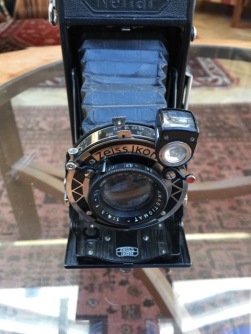The image you see above was taken on a freezing cold, steel gray day which the UK seems to get under high pressure in the winter. Light levels are low and very flat.
It was under such trying conditions I decided to test a 1930’e Zeiss Ikon 515/2 camera.
The test subject was the city where I live, Lincoln in the East Midlands of England. Hardly the South of France on a sunny day but…
I used 400asa Ilford XP2 (c41 film) because I could take it into the local Snappy Snaps shop to get it processed quickly. I’m impatient you see.
For those who may be interested, the shot was hand-held with a shutter speed of 1/50th of a second and an aperture of f5.6 It barely froze the people who were walking.
 This is the camera. It’s a folding camera with bellows separating the film and lens planes. It’s odd and clunky but despite being over 80 years old it’s still serviceable and still produces more than adequate images.
This is the camera. It’s a folding camera with bellows separating the film and lens planes. It’s odd and clunky but despite being over 80 years old it’s still serviceable and still produces more than adequate images.
It has a focus ring, an aperture setting, and a speed setting. It has no autofocus, no distance rangefinder, and no exposure meter. You do all of that yourself. Yes, it’s very old school.
It takes 8 exposures each with a massive negative size of 60mm X 90mm on a roll of 120 film.
I’ve looked at the negatives through a 40x loupe. There is a slight softness to them but not enough to discount the images at all. In fact, that’s probably its charm.
Photographers of today seem to put too much emphasis on the ability for their cameras to produce images which are needle point sharp – as if that is all there is to photography. Yes, it’s important but sharpness is not the be all and end all. Was it Bresson who said, “Focus is such a Bourgois issue”?
To answer the question “Just how much better are today’s cameras?”… They are certainly easier to use, many requiring no input from the person other than to press the shutter release. They certainly produce consistently well-exposed images with their inbuilt metering systems, and, of course, the autofocus will do that job for you too.
But you can see the image quality of an 80-year-old mid range camera isn’t bad, though of course, lenses have improved too.
The answer is that modern day cameras have improved markedly from their aging grandfather’s. But, in doing so what have we lost? The skill and craftsmanship of the photographer perhaps? Certainly, modern cameras can be very much point and shoot so if you press the shutter enough times you are going to get at least one shot which is good, so from that standpoint, I would argue yes, the skill levels required have diminished.
Lastly, I noticed an odd thing… nobody took any notice of me at all. With a modern camera pointed at them people become prickly. But with this, I was invisible.
Go and buy an old camera (with a good lens) and run a roll of film through it. You may get surprised by the results.
And we haven’t even started on film versus pixels…
Let’s not go there.

Having started with a manual camera, no light meter, no autofocus etc. I understand your point. However, I do appreciate the new tech, even if it does not always work as well as advertised.
LikeLiked by 1 person
It’s a smashing shot.
I suppose the difference between someone like you – a photographer – and me – someone who simply enjoys taking photos – is I am very likely even more impatient than you are so digital means I can wander into the garden, shoot fifty shots of a crab spider and come back and view them within ten minutes and there will be around a half dozen I’m happy with.
One of the reasons I partially gave up taking pictures back in the day was the expense of film and development. Although still have my Olympus OM10 and a decent Tokina telephoto.
LikeLike